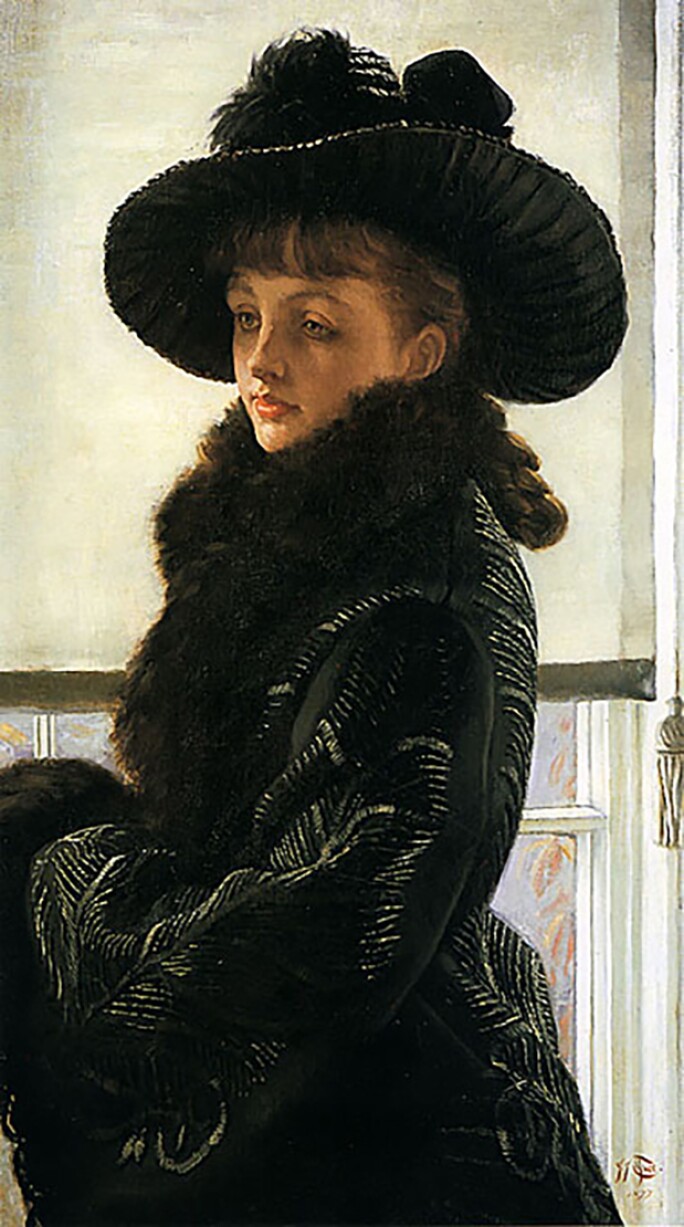In the last years of the 1870s George Clausen painted an unidentified young woman in a series of paintings of modern life, including The Novel of 18791, Phyllis of 18802 and La Pensée also dated 18803 which was shown at the Grosvenor Gallery. In these pictures, the beautiful model is posed in an interior with carefully composed furniture and other properties. Clausen was clearly attempting to paint the style of the Aesthetic Movement that was in fashion. At the same time he painted the same girl in a series of outdoor settings, chic in black and white in, In the street of 18804 and in sumptuous deep-blue in the present picture; A morning walk of 1881. The mysterious young woman in these pictures was probably an artist’s model and appears in the pictures by Clausen’s friend, Fred Brown.

Right: Fig. 2 Sir George Clausen, Schoolgirls. Oil on canvas, 52 x 77 cm. Yale Centre for British Art, Paul Mellon Collection, Yale.
Clausen’s new subject-matter coincided with his move from Moore Park Road in Fulham to 4 The Mall, Hampstead around the end of 1878. Although the model was probably painted in his studio, the settings were of London and the titles of two of them gave a specific location, A spring morning, Haverstock Hill (fig 1) and the watercolour Schoolgirls, Haverstock Hill (private collection). The most ambitious of the series is Schoolgirls of 1880 (fig. 2) which depicts a battalion of young women in dresses of various hues, marching along a pavement – most of whom are careless of a young flower-seller, a milk-maid burdened with her pails or a young governess with her ward. A morning walk makes a similar social comment by contrasting the elegance of the young woman with a labourer sharing the pavement, dressed in work-clothes and with a pick over his shoulder. We also see a mother and an infant girl – perhaps a reference to the previous and future life of the girl who looks directly at us with her deep violet eyes and enigmatic expression which is neither coy nor confrontational. There is an uneasy tension in the juxtaposition of the social ranking of the figures and this deliberate awkwardness is emphasised by the dynamic diagonal line of the street itself which slices through the background – a great, dusty gulf between the young lady and her counterpart on the other side of the road.

Clausen was influenced by French art at this time, particularly the glamorous paintings and etchings by the émigré James Tissot who was living in St John’s Wood and painting his muse and mistress Kathleen Newton in pictures like Mavourneen of 1877 whose black dress, furs and voluminous hat are very similar to those worn in Clausen’s A morning walk painted a few years later (fig. 3). Clausen would soon move on from these scenes of London pavements to rural images of farm labourers and their children, but for a brief few years they captured his imagination as he sought to depict the rapidly changing age in which he lived and the contrasts between the men and women he painted.
1 Sold in these Rooms, 4 March 1998, lot 34. Oil on canvas, 51 x 33 cm. Private collection.
2 Oil on canvas, 65 x 30 cm. Gallery Oldham, Oldham. No. 3.55/3.
3 Oil on canvas, 124 x 73 cm. Kelvingrove Art Gallery and Museum, Glasgow.
4 Anonymous sale, London, Christie’s, 11 June 2003, lot 10. Oil on canvas, 24 x 17 cm.